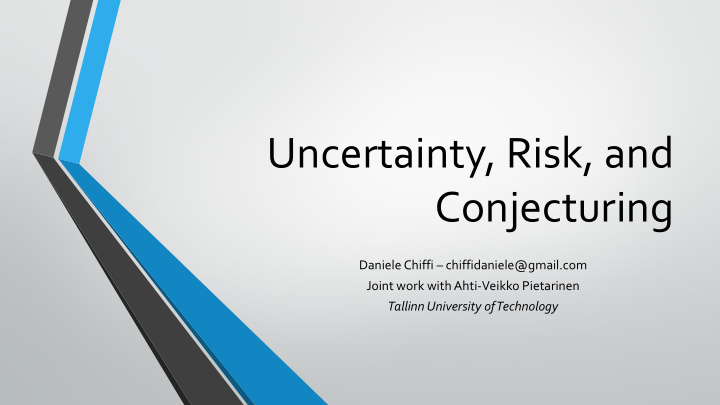



Uncertainty, Risk, and Conjecturing Daniele Chiffi – chiffidaniele@gmail.com Joint work with Ahti-Veikko Pietarinen Tallinn University of Technology
Uncertainty • Epistemology and epistemic logic are not usual topics of discussion in politics. Notable exceptions are the following sentences taken by a news briefing of the former US Defense Secretary Donald Rumsfeld. He asserted that
Unknown knowns Rumsfeld’s statements can express a stimulating way of making sense of knowledge and uncertainty. As later recognized by Rumsfeld in a 2013 documentary called The Unknown Knowns , a four category is missing in his classification, that is, unknown knowns that he defines as “things – that you may possibly know – that you do not know you know”
A Taxonomy of Knowldge and Uncertainty • Based on this Rumsfeld’s taxonomy of levels of knowledge, it is possible to classify hazards, in the sense of potential harms, by considering the occurrence of an event and its consequences. (1) In case of known knowns we both know the occurrence and the consequences of a hazardous event, (2) In presence of known unknows (conditions of risks) we know the event but not its occurrence and its consequences, (3) For unknown knowns the existence of the event is unknown but we already know the consequences associated to that event, (4) In case of unknown unknowns (conditions of fundamental uncertainty ) both the event and its occurrence and consequences are unknown.
• Fundamental uncertainty is not probabilistic • Risk is the probability “that a particular and exemplifies the mostly common form of adverse event occurs during a stated period of uncertainty that we experience in daily life time, or results from a particular challenge” (Royal Society 1992, 2). The Royal Society takes risk here “as a probability in the sense of statistical theory”, which obeys “all the formal laws of combining probabilities”.
Tuxedo fallacy • Confusion of situations of risk with situations of fundamantal uncertainty • Probabilistic risk assessment cannot be always used for future scenarios • Risk ---> Casinò • Fundamental Uncertainty ---> Jungle
Unknown Unknowns • Since it is difficult to methodologically deal with unknown unknowns (Fundamental uncertainty) , then people are more likely to completely ignore them (Alles 2009). • This type of error is very common in science and society, since not all hazardous situations can be identified and fully evaluated. • But completely ignoring unknown unknowns can be disastrous. • We need to imagine alternative scenarios and being prepared to deal with completely new events. • Probabilistic trends are not reliable for remote futures.
Abduction • This is particularly true in science. • Discoveries cannot be based just on blind luck, chance, or serendipity • Research is grounded on exploiting uncertainty, making use of the unknown unknowns • What is the generator of processes of coping with uncertainty and ignorance? – Abductive reasoning
Abduction 1. The surprising fact, C, is observed 2. But if A were true, C would be a matter of course 3. Hence, there is reason to suspect that A is true. • Abduction seeks a hypothesis to account for facts by guessing • is fallible , preserves ignorance , is not intended to generate new knowledge 9
Elements of Abduction • P0. Abduction is triggered by surprise. • P1. Abduction is a form of guessing. Since we are rather remarkably good at guessing, it can only be supposed that we are likewise rather good at abducing. • P2. A successful abduction provides no grounds for believing the abduced proposition to be true (Peirce, 1992, p. 178). • P3. Rather than believing them, the proper thing to do with abduced hypotheses is to send them off to experimental trial ( CP , 5. 599, 6. 469-6. 473, 7. 202-219). • P4. The connection between the truth of the abduced hypothesis and the observed fact is subjunctive ( CP, 5. 189) • P5. The inference that the abduction licenses is not to the proposition H, but rather that H’s truth is something that might plausibly be conjectured ( CP, 5. 189) • P6. The “hence” of the Peircean conclusion is ventured defeasibly ( CP, 5. 189)
• Tychism is a value that states that nature pursues randomness. Nature is in Peirce’s words “constantly receiving excessively minute accessions of variety” (R 292a). Laws, including laws of logic, are results of evolution. • Synechism is a value (rather than a metaphysical principle), which insists on the “idea of continuity as being of prime importance in philosophy ” (CP 6.169, 1902 ).It regulates what logical hypotheses are to be entertained, and which are those that are to be further examined. • Uberty is a value of hypotheses that tells when they would be suspected to be good in their character of productiveness. Peirce’s terms, a hypothesis is uberous, if it is “ gravid with young truth” (EP 2:472), that is, it encourages invention and discovery in its capability of suggesting certain other, new and connected hypotheses in case the original, low-security one fails to survive for long.
Conclusion • Philosophical methods can be extremely useful in dealing with fundalmental uncertainty (unknown unknowns) • Abduction seems to play a major role as a methodological tool for decisions in conditions of fundamental uncertainty • Abduction, unlike probabilistic risk assessment, is about the plausibility of hypotheses, not their probability • Abduction calls for action. Abducted hypotheses may be exprerimentally tested.
Recommend
More recommend